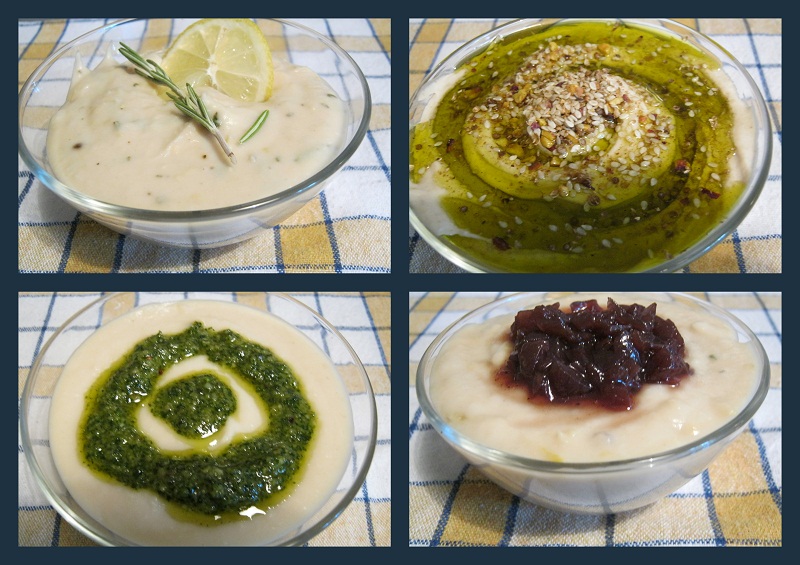Rachel's recipes: Fasole Batuta five winsome ways…

 ….with Tahini and Dukkah, with Pesto, with Red Onion Marmalade, with Rosemary & Lemon and as healthy mash!
….with Tahini and Dukkah, with Pesto, with Red Onion Marmalade, with Rosemary & Lemon and as healthy mash!
Fascinated with Hummus? Titivated by Ful Medames? Enraptured by re-fried Pinto Beans? This troupe of pastes have long hogged the leguminous paste limelight but it's time white bean puree or “fasole batuta” took center stage and showed us just how posh it can be.
I love the traditional FB with tons of sweet caramelized onions on top as much as anybody, but the adaptable paste can offer so much more. It makes a great dip, a fabulous canapé spread on crostini or a healthy alternative to mashed potato, as seen in the world’s most cutting edge restaurants, partnering seared tuna, roast trout or lamb chops with panache. It's high in protein and fiber, magnesium and essential B vits, so waste no time and embrace the smarter paste!
Gadgets & Gizmos
A blender – either a stick one or a food processor. If you like a chunky consistency and manual labor then a potato masher can be used.
Timeline & Planning
The best method is to soak the beans overnight with some bicarbonate of soda. The beans swell up and absorb the water and the bicarb softens the skins aiding the digestion process. However cooking from “dry” wont be a disaster it will just take longer and use more of the world’s shrinking energy resources cooking them.
Ingredients for basic white bean paste or “fasole batuta”
- 500g white beans (“phaesolus vulgaris”) aka cannelini beans in Italy, Navy Beans in the US and “fasole” in Romania. Check over carefully for stones, straw and extra wildlife, especially if you are a vegetarian.
- 2tsp of bicarbonate of soda
- Water to generously cover the beans (probably 5cm over the beans in a saucepan)
- Sunflower or olive oil
- 2-6 cloves of garlic according to personal taste
- salt
How To
Rinse the soaked beans to eliminate the salty bicarb flavor. Add fresh water and bring to the boil. Add the salt. Simmer for 20-30 minutes until the beans are very soft and “mushy”. Add the oil (personal taste - add more oil, no oil and use some of the cooking liquid, add lemon juice) and blend until creamy in texture. For the traditional recipe thinly slice two onions (I like the color contrast of red onions) and fry them in a tiny amount of oil slowly slowly until they change color and are “caramelized” – approx 45 mins on a low heat. I like to serve red onion marmalade as a similar and handy idea.
Ideas and Variations
With Tahini and Dukkah
Adding tahini will thicken any paste (including dressings) as the tahini emulsifies the sauce and thickens it, much as oil added to a mayonnaise base does. So adding tahini and beating vigorously will thicken the texture of the paste. Having almost burnt out many motors on the less forgiving hummus I can say that the fasole batuta version is more forgiving.
To 300g of base fasole batuta add 100ml of tahini and 1 tsp of cumin. You don’t have to add the cumin and you can argue that the spices in the Dukkah make it unnecessary, but I quite like it. Beat or blitz and serve with very good olive oil swirled on top and a liberal sprinkling of Dukkah. Just add some good flatbread.
With Pesto
Drizzle proper home made pesto on top of the basic fasole batuta. Its also interesting to actually mix it in and make a basil flavored paste.
With Rosemary and Lemon
To 300g of basic fasole batuta add the leaves of two sprigs of rosemary and the zest of one lemon (you can add the juice too to the basic mix but take care it doesn’t become too liquid)
As a Mash
Here the texture needs to be slightly more liquid, or akin to smooth and creamy mashed potatoes. Use this mash as per your potato based favorite. It's quite a neat trick to drizzle some pesto over the mash before topping with your piece of fish, meat or yes, real sausages! Red wine & fennel sausages atop a pesto drizzled fasole mash? YUM central.
By Rachel Sargent, Guest Writer
Rachel Sargent is the chef and owner of the London Street Bakery, which offers healthy seasonal food. More about it here.











